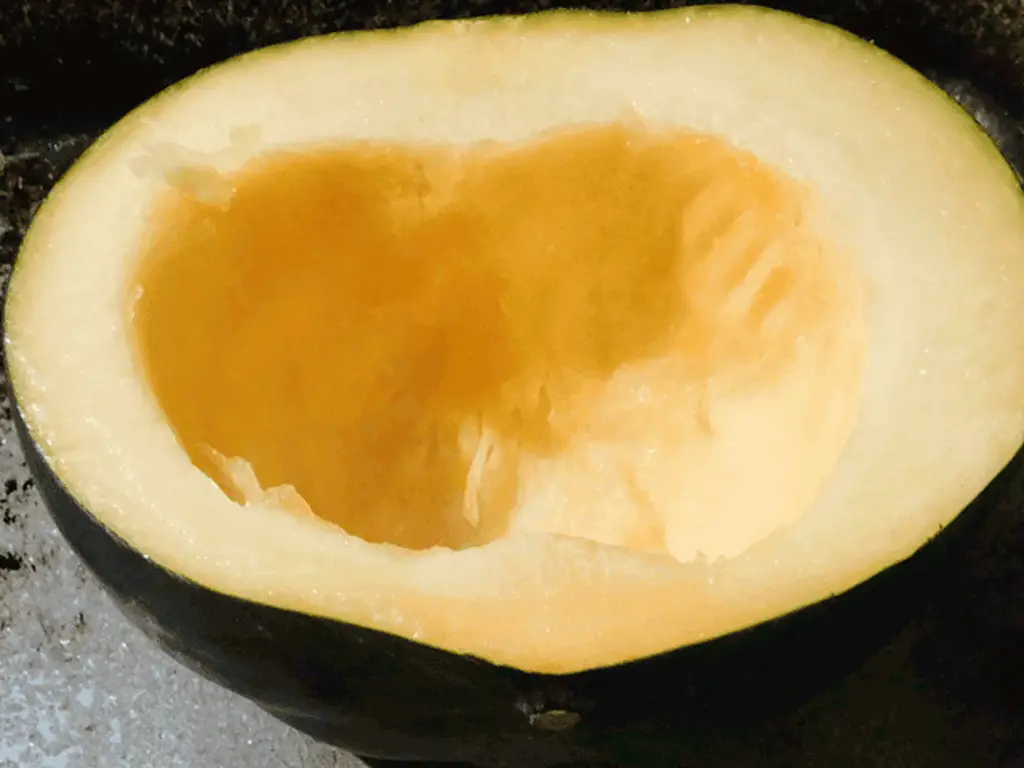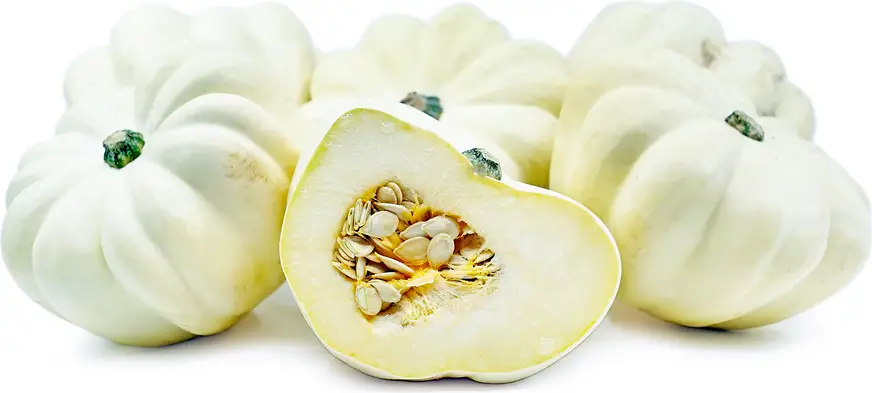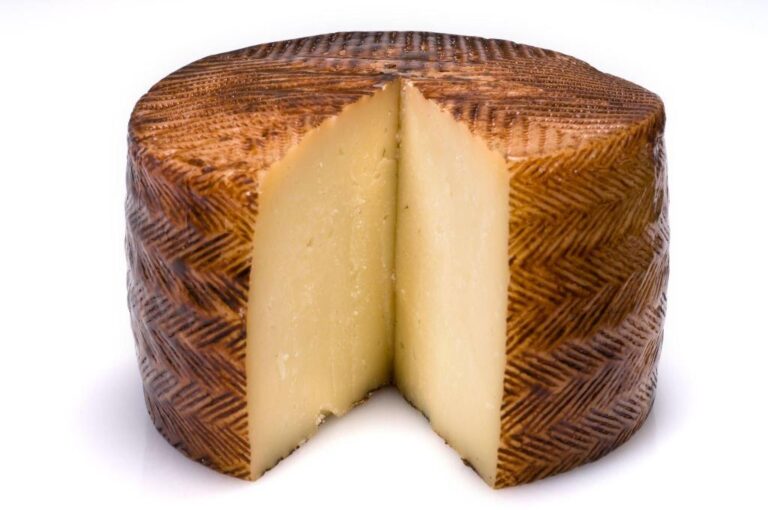Acorn Squash White Inside: Is It Still Safe to Eat?

Acorn squash, with its distinct shape and vibrant orange exterior, has long been a beloved ingredient in kitchens around the world. From savory stews to comforting soups and even sweet desserts, this versatile vegetable adds a delightful twist to countless dishes.
We all know that when you slice open an acorn squash, you expect to find rich golden-orange flesh tucked within. But recently, there has been a lot of talk about an odd thing about acorn squashes that has some people scratching their heads: the flesh inside the squash is white. So naturally, stumbling upon a snowy-white surprise can be quite unsettling.
Questions arise – is it safe to eat? Has the squash gone bad? In this article, we will shed light on the mystery behind acorn squashes with white flesh and put any concerns to rest.
What Is the White Stuff Inside A Corn Squash?
When you cut open your acorn squash, the white stuff inside might prompt curiosity. Essentially, there are two possibilities:
1. Sugars and Milky Starch Blend:
The white liquid you observe is a mix of sugars and milky starches. This natural occurrence is perfectly safe to eat, contributing to the vegetable’s flavor profile. It adds a subtle sweetness and creaminess, enhancing the overall culinary experience.
2. Mold Growth
On the flip side, if you notice a white substance that seems more like fuzzy growth, it’s likely mold. Mold can develop around damaged areas, and consuming it is not safe. It’s crucial to differentiate between the normal sugar-starch blend and mold growth to ensure a pleasant and safe dining experience.
3. Genetic Variation
One possible cause is genetic variation or mutation within the squash plant itself. Just like how humans can have different hair colors due to genetic differences, squashes can also exhibit variations in their pigmentation. These mutations can result in white-colored insides rather than the more common orange or yellow tones.
Spotting the Difference:
Here’s a quick guide to help you distinguish between the two:
| Characteristic | Safe to Eat? |
| Milky liquid around squash | Yes |
| Fuzzy, mold-like growth | No |
| Genetic Variation | Yes |
Is It Still Safe to Eat? Addressing Common Worries and Providing Reassurance

It’s not uncommon for people to feel concerned when they come across an acorn squash with white flesh inside. After all, we are creatures of habit, and anything that deviates from the norm can trigger our caution instincts. But fear not! White interior pigmentations in acorn squashes don’t pose any inherent health risks.
To put your mind at ease, let’s delve into the science behind these color variants. The white flesh in some acorn squashes is usually caused by elevated levels of carotenoids called phytofluene and phytoene. These compounds are natural pigments found in various fruits and vegetables, including tomatoes and watermelons.
While most acorn squashes have orange or yellowish flesh due to high beta-carotene content, those with white-colored interiors simply have a different arrangement of carotenoid pigments.
Research has shown no evidence suggesting negative health implications from consuming squashes with white interior pigmentations. In fact, diverse pigmentation indicates a wider variety of beneficial nutrients that can complement your diet. So go ahead and embrace this unusual color variant as another exciting addition to your culinary repertoire!
| Related: Can You Eat Raw Unripe Acorn Squash? |
How to Identify Fresh Acorn Squash?
When it comes to identifying fresh acorn squash, paying attention to key physical characteristics is the first step. These visual cues can guide you towards selecting the best produce for your culinary endeavors:
1. Weightiness
Opt for an acorn squash that f a s heavy for its size. This indicates a higher water content, a sign of freshness.
2. Firmness
Gently press the exterior. Fresh acorn squash should yield slightly to pressure but remain firm overall. Avoid squash with soft spots or excessive give.
3. Stem Condition
Check the stem where it was once attached to the vine. A healthy, intact stem is a positive indicator of freshness.
Choosing Quality Sources
Ensuring that you source your acorn squash from reputable places is equally crucial. Consider these tips for selecting quality produce:
Farmers’ Markets
Explore local farmers’ markets where you can connect directly with growers. Freshness is often prioritized, and you get the added benefit of supporting local agriculture.
Organic Produce Sections
Look for acorn squash in the organic produce sections of grocery stores. These sections typically adhere to strict quality checks, ensuring you get a product that meets higher standards.
By combining a keen eye for physical characteristics and choosing reliable sources, you’ll be well on your way to enjoying the delightful taste and nutritional benefits of fresh acorn squash.
Detecting Signs of Spoilage Acorn Squash
Identifying whether your acorn squash has gone off involves recognizing specific visual and tactile cues. Here are key indicators to help you determine the freshness of your squash:
- Visual Examination:
- Check for changes in color; a dull appearance or dark spots may signal spoilage.
- Inspect the skin for any visible mold, especially around the stem or damaged areas.
- Texture and Firmness:
- A fresh acorn squash should feel firm when gently pressed.
- If the skin appears wrinkled or there are soft spots, it may be an indication of spoilage.
- Smell Test:
- Fresh acorn squash has a mild, earthy aroma. Any unpleasant or sour smell may suggest spoilage.
- Mold Growth:
- Mold growth is a clear sign of spoilage. Check for any fuzzy, white, or green patches on the skin.
Quick Reference Table:
| Indicator | Fresh | Spoiled |
| Color | Bright and vibrant | Dull or dark spots |
| Texture/Firmness | Firm and smooth | Wrinkled or soft spots |
| Smell | Mild, earthy aroma | Unpleasant or sour |
| Mold Growth | Absence of mold | Fuzzy or discolored patches |
By utilizing these indicators, you can confidently assess the quality of your acorn squash and ensure a delightful culinary experience.
Acorn Squash Recipes & Recommendations
Looking for some culinary inspiration to make the most of both traditional orange-fleshed squash and its white-fleshed variants? Look no further! Acorn squash, regardless of the color inside, can be incredibly versatile in the kitchen.
Let’s explore a couple of recipes that will not only showcase these squashes’ unique attributes but also encourage you to get creative in your cooking.
First up, let’s talk about a classic recipe that highlights the natural sweetness and creamy texture of orange-fleshed acorn squash: roasted maple cinnamon acorn squash. This dish brings out the delectable flavors by simply halving the squash, removing seeds, and roasting it with a drizzle of maple syrup and a sprinkle of cinnamon. The result is tender flesh with caramelized edges – perfect as a side dish or even as part of your Thanksgiving spread!
Now, onto an exciting recipe using white-fleshed acorn squash: ginger coconut curry stuffed acorn squash. This flavorful dish combines aromatic spices like ginger and turmeric with rich coconut milk to create a hearty filling for scooped-out white-accentuated squashes. Baked until tender on the outside with delightful curried goodness inside, this meal offers an enticing fusion of Asian-inspired flavors.
These two recipes are just scratching the surface when it comes to exploring different cooking methods and flavor profiles between orange- and white-fleshed varieties.
Whether you prefer roasting, stuffing or pureeing them into soups or stews – there are endless opportunities for experimentation in your kitchen! So embrace both types of acorn squashes in your culinary repertoire and get ready to enjoy their distinct textures, tastes, and colors.
Embrace the Versatility: Exploring New Culinary Experiences
Now that we know that acorn squash with white flesh is perfectly safe to eat, it’s time to embrace the versatility of both types of squashes and discover new culinary experiences. Whether your acorn squash has orange or white flesh, there are endless possibilities in the kitchen.
With their sweet and nutty flavor, orange-fleshed acorn squashes are often roasted or baked, making them a delicious side dish or even a main course when stuffed with savory fillings like quinoa or sausage. The soft texture of these squashes also lends itself well to being pureed into soups or mashed as a tasty alternative to potatoes.
On the other hand, don’t underestimate the potential of acorn squash with white flesh. Its subtle taste pairs beautifully with flavors such as sage, cinnamon, and buttery sauces. Slice it thin and use it as an unexpected twist on chips by lightly frying them until crisp. Or try incorporating it into hearty stews for added richness.
By embracing the versatility of both types of acorn squash, you open up a world of exciting recipes and flavors that will delight your taste buds. So next time you’re at the grocery store or farmers market, grab whichever version catches your eye – be it radiant orange or creamy white – and let your creativity shine in the kitchen!
Conclusion
In conclusion, the enigma of encountering an acorn squash with a white interior raises questions about its edibility and safety. Through our exploration of different acorn squash varieties, signs of mold, culinary safety practices, and nutritional value, we’ve gained valuable insights into this intriguing vegetable.
The white interior of acorn squash, often a natural occurrence in certain varieties, doesn’t necessarily signal spoilage. Understanding the diverse characteristics of acorn squash, including its color variations, allows us to appreciate the richness and uniqueness each variety brings to the table.
When faced with the concern of a white interior, it becomes crucial to differentiate between normal color variations and signs of mold. Identifying mold, such as through visual cues and sensory indicators, is vital to maintaining both the flavor and safety of the squash. Our culinary safety practices provide a roadmap for handling, storing, and preparing acorn squash to ensure a delightful and risk-free culinary experience.
As we navigate the landscape of acorn squash, it’s essential to consider the nutritional value it offers. Rich in essential nutrients, acorn squash remains a valuable addition to a healthy diet, irrespective of its interior color. This nutritional profile further underscores the importance of making informed choices when faced with the question of edibility.
For those pondering the dilemma of “my acorn squash is white inside, paa,” this article serves as a guide to ease concerns and facilitate informed decision-making. Whether you’re an avid cook, a health-conscious individual, or someone intrigued by the diverse world of vegetables, understanding the intricacies of acorn squash contributes to a more enjoyable and safe culinary journey.
In the realm of acorn squash, the interplay of colors, flavors, and safety considerations adds layers of complexity, making it a fascinating subject of exploration. Embrace the culinary adventure, savor the flavors, and let your understanding of acorn squash with a white interior enhance your appreciation for this versatile and nutritious vegetable.
Remember, the key to enjoying acorn squash lies not only in its preparation but also in the knowledge that empowers you to make confident and informed choices. Happy cooking, and may your acorn squash adventures be both delicious and safe.






